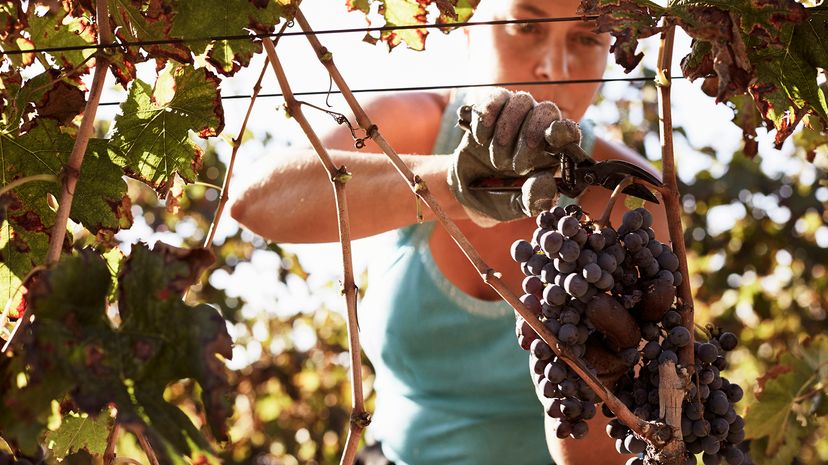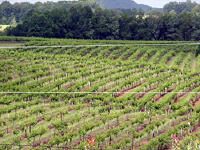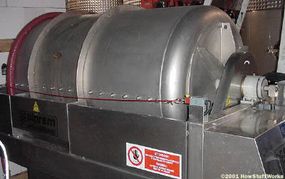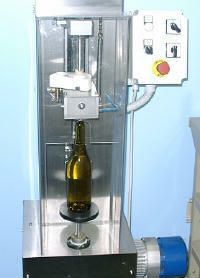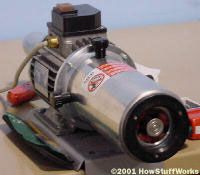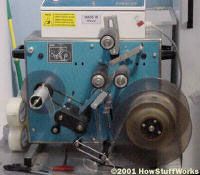Learn how wine is made, from grape to glass. Morsa Images / Getty Images
The average United States resident drinks 3.18 gallons of wine — about 80 glasses — a year. Many people enjoy wine with a meal or have wine at social functions, and research has found an association between light to moderate wine-drinking and reduced risk of cardiovascular disease.
Wine is an alcoholic beverage derived from grapes by fermentation, much the way beer is derived from the fermentation of grains. Unlike beer, wines are not carbonated (except Champagne and sparkling wines). They also have about twice the alcohol content of beer. In this article, we will examine the steps in the fascinating process of winemaking.
Special thanks to Paul Henkens for our personal tour of the Chatham Hill Winery in Morrisville, N.C.
Fruit of the Vine
Grapes for winemaking are grown in many areas of the U.S., as well as other countries such as France, Chile and Australia. The major wine-producing area in the U.S. is California, which accounts for 80 to 90 percent of U.S. wine production. Many categories of wine grapes are grown throughout the country and include the following:
Vitis vinifera: European type, such as Chardonnay, Cabernet Sauvignon, Merlot, Sauvignon Blanc and RieslingFrench-American Hybrids: Baco Noir, Chambourcin, Seyval Blanc, Vidal Blanc and Villard NoirVitis labrusca: American-type grapes, such as Catawba, Concord, Delaware and NiagaraVitis rotundifolia: native to North Carolina, such as Carlos, Magnolia and Scuppernog
A vineyard
Photo courtesy Chatham Hill Winery
Typically, the type of grape that is used to make the wine gives the wine its name, such as Chardonnay, Cabernet Sauvignon and Zinfandel. However, some wines are blends of various types of wines, such as a Semillon Chardonnay. The blending of various wines to produce a given flavor is part of the art of the winemaking.
Viticulture
Growing grapes, a process known as viticulture, involves a complex interaction (terroir) between the following factors:
Soil: Soil influences how much water and heat are available. Grapes need a steady, but not excessive, water supply.Color: Dark soils tend to be warmer than light soils because they are better at absorbing and holding heat.Geology: Rocky or stony soils allow water to drain better than clay soils; rocks also help to absorb heat in the soil.Chemicals: The role of chemicals in the soil is delicate (more information below).Topography: This influences the amount of sunlight available (temperature) and the drainage (water supply).Microclimate: This influences temperature, sunlight and water (rainfall, fog, mist). Some grapes, such as Vitis vinifera, tend to grow best in areas where the seasonal temperature varies by about 30 to 35 degrees Fahrenheit (17 to 19 degrees Celsius).
The types of grapes that are planted and grown in any given area depend upon the terroir. In the Northern Hemisphere, grapes begin to bud in late March or early April. The grapes grow, bloom and develop fruit throughout the summer.
The grower’s goal is to keep the leaf growth small, which allows more sun in and keeps the grape clusters small yet numerous. The growers must also watch for signs of drought, disease and pests.
In late September or early October, the grapes are ready to harvest. The actual times vary with the climate, latitude and judgment of individual growers.
Chemicals in the Soil
While the role of chemicals in the soil is not clearly understood, we do know that:
Too much nitrogen yields heavy leaf growth and shade, while too little produces hydrogen sulfide.Too little potassium makes plants vulnerable to drought and disease and yields grapes that are low in sugar.pH is not critical, because grapes grow in a variety of soil pH levels.Too much organic material yields too much nitrogen and water, but too little will not support many soil organisms (earthworms).
Get Your Feet Wet
In the fall, it is crush time. The grapes are harvested. Some vineyards use mechanical harvesting techniques, but most hire workers to pick the grapes by hand.
The grapes are then brought to the winery. Many wineries are located on or near the vineyards. If the wineries are far away, the grapes are shipped in refrigerated trucks.
Once the grapes reach the winery, they get crushed. Inside the crusher, there is a perforated, rotating drum. The holes in the drum allow the juice and the skins of the grape bunches to pass through, but keep the stems inside the drum. The crushed grapes and juice are called must.
What happens next depends on the type of wine.
To make red wine, winemakers send the must directly to the fermentation tanks. To make white wine, they first send the must to a wine press, where the grape juice is separated from the skins, because white wines are fermented from skinless grapes.
Skin-contact wines, also called orange wines, and some rosé wines are made from white-wine grapes fermented on the skins for a short period. (Most rosé wines, however, are simply a blend of red and white wines.)
A wine press separates the juice from the skins.
The wine press consists of a stainless steel cylinder with an inflatable rubber bladder inside. The must is poured inside the cylinder and the bladder is inflated with air. The bladder squeezes the skins against the side of the cylinder and forces the juices out.
The juices are collected and sent to the fermentation tanks. At some wineries, the skins are recycled to local nurseries for fertilizer.
Sell No Wine Before Its Time
The must, whether from red grapes or pressed white grapes, is ultimately sent to the fermentation tanks. The fermentation tanks are airtight, made of stainless steel and can hold 1,500 or 3,000 gallons (5,678 or 11,356 liters).
The tanks are cooled with glycol to maintain a temperature in the 40 F range (4 C range). The winemaker adds sugar and wine yeast to start the process of fermentation. The type of yeast and the amount of sugar added depends on the type of grape and style of winemaking.
Fermentation Begins
When the yeast first hits the must, concentrations of glucose sugar (C6H12O6) are very high, so it is through diffusion that glucose enters the yeast. In fact, it keeps entering the yeast as long as there is glucose in the solution.
As each glucose molecule enters the yeast, it is broken down in a 10-step process called glycolysis. The product of glycolysis is two three-carbon sugars, called pyruvates, and some ATP (adenosine triphosphate).
ATP supplies energy to the yeast and allows it to multiply. The two pyruvates are then converted by the yeast into carbon dioxide gas (CO2) and ethanol (CH3CH2OH), which is the alcohol in wine.
The alcoholic fermentation process, sometimes called primary fermentation, takes anywhere from two weeks to about a month. During this time, the winemaker samples the fermenting must and measures the pH or acid levels and sugar content to determine that the fermentation process is proceeding as it should.
To make a dry wine, the winemaker will allow the yeast to transform all of the sugar into alcohol. When making a sweet wine, winemakers will stop the fermentation process before all of the sugar has turned into alcohol.
Storage
Once the fermentation process is completed, red wines are sent to the press to separate the grape skins from the wine. The red wines are then filtered to remove the yeast. White wines are allowed to settle and are filtered to remove the yeast.
Once the yeasts are removed, winemakers store wine in either stainless steel storage tanks or oak barrels (oak gives many wines a characteristic flavor), depending on the type of wine.
Malolactic Fermentation
In some red wines, a secondary fermentation, called malolactic fermentation, is undertaken while in storage.
During this additional fermentation step, the winemaker adds a bacteria to the wine mixture that breaks down malic acid, a byproduct of aerobic (oxygen-requiring) metabolism, into lactic acid, a byproduct of anaerobic (no oxygen) metabolism.
Lactic acid is a milder acid than malic acid. The aging process can be anywhere from three months to three years.
Sulfites
Sulfur-containing compounds called sulfites are naturally found on grapes to retard the growth of bacteria and mildew. Most winemakers add sulfites to the wine to prevent bacterial spoilage and help stabilize it as it ages.
However, some people are allergic to sulfites — wines that are labelled as sulfite-free have had the sulfites chemically removed.
Cork in the Bottle
After the wine has aged sufficiently, as determined by the winemaker, it is time to bottle and package it for sale. The operator pumps the finished wine from the storage tank to the bottling machine. There, glass bottles are loaded by hand and a premeasured amount of wine flows into each bottle.
After each bottle is filled, the operator removes it and places it in the corking machine. The machine draws a vacuum inside the bottle that sucks the pre-loaded cork into the neck of the bottle.
After the bottle is corked, the operator places the neck into the foil machine, which seals an aluminum foil wrapper over the cork.
Next, the operator moves the bottle to the labelling machine, where the winery’s self-adhesive label is placed on the bottle. Finally, the operator loads the bottle into a case for shipping and distribution.
Many wineries offer tours so you can see the winemaking process. They may also have tasting rooms where you can sample and purchase their products.
Champagne
Champagne and other sparkling wines are treated somewhat differently than other wines:
The grapes are grown and fermented the same as with any other wine.After fermentation, the wines are aged for about five months.The wine is bottled with extra wine yeast and more sugar. The wine bottles are capped to allow for a second round of fermentation, which lasts for about a year.The wine is aged for one or more years after the second fermentation.The yeast is removed through riddling, whereby the bottle is placed upside-down and rotated one-eighth of a turn every day. The dead yeast cells settle into the neck of the bottle.The neck of the bottle is frozen in an ice/salt water bath and the cork is removed. The pressure forces the frozen plug of dead yeast cells out of the bottle. This process is called disgorging.A mixture of white-wine brandy and sugar (dosage) is added to top off the bottle.The bottle is corked and wired to secure the high pressure inside.
Homemade Wine
The steps taken by commercial wineries can be carried out at home in a cool basement. Many people enjoy making wine from grapes that they have grown themselves or grapes that they have purchased.
You can also go beyond grape wine and make homemade fruit wine, called country wine, from fresh fruit like blackberries, strawberries, plums or peaches.
Several home-winemaking kits are available, and there are stores that cater to the home winemaker by selling equipment and giving advice. Equipment and and wine recipes are readily available over the Internet.
Frequently Answered Questions
How is wine made, step by step?
The winemaking process begins with the grape harvest. Grapes are picked by hand or by machine and are then crushed and pressed. The juice that comes out of the grapes is called must, and this is what will be fermented to produce wine. After the grapes are pressed, the must is transferred to a fermentation vessel where yeast is added. The yeast will eat the sugar in the must and convert it into alcohol. This process of fermentation can take anywhere from a few weeks to a few months. Once the fermentation is complete, the wine is then transferred to barrels or wine bottles for aging. This aging process can last for years, and it is during this time that the wine develops its complex flavors and aromas.
>>> Read full article>>>
Copyright for syndicated content belongs to the linked Source : How To Stuff – https://science.howstuffworks.com/innovation/edible-innovations/winemaking.htm








